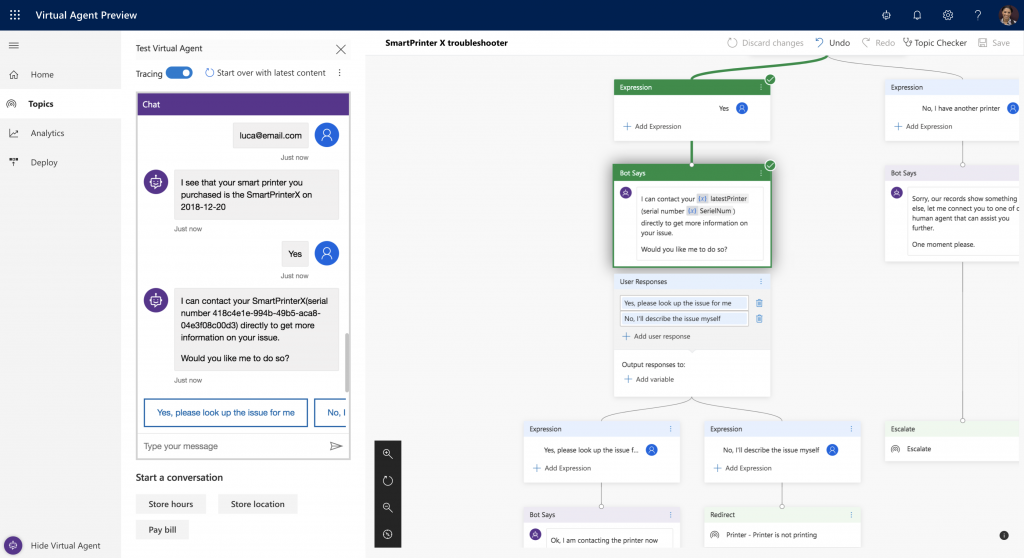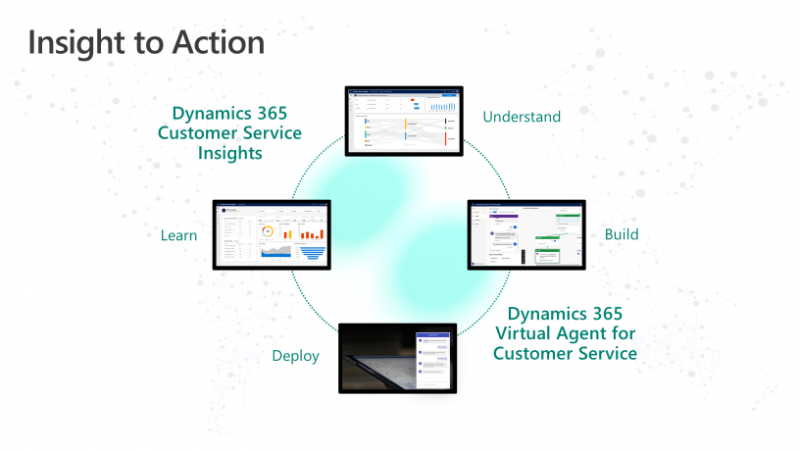
New! Dynamics 365 Virtual Agent for Customer Service is available for preview
It is with great pleasure that we’re announcing availability of the public preview of Dynamics 365 Virtual Agent for Customer Service. Virtual Agent for Customer Service is the latest Dynamics 365 AI-based end-to-end solution enabling organizations to easily transform customer service through the power of artificial intelligence (AI).
Virtual Agent for Customer Service is built on top of the Microsoft Bot Framework and is the culmination of years of learning from our team here at Microsoft. We’ve gained deep knowledge and hands-on expertise from creating and operating the Microsoft customer service virtual agent, which provides support to millions of Microsoft customers worldwide every month and helps develop customer service bot solutions for industry leaders such as Macy’s and HP, Inc.
However, developing the technology for these bespoke virtual agents was just the beginning. In addition to the implementation of the bots, we owned the success of the customer experience the bots delivered, including working with lots of product teams to deliver the crucial content and deliver it well. All of these learnings have formed the basis for creating the Dynamics 365 Virtual Agent for Customer Service SaaS offering we are launching today.
Our key focus has been to change the game by making creation of virtual agents simple, without making the resulting bots simplistic. We want you to be able to focus on the content of the bot and easily create powerful virtual agents that engage in personalized conversations with your customers. Bots that can drive actions to truly resolve a customer’s problem, all without the need to be a developer, AI expert, or data scientist.
Lessons learned
Here are the key learnings we had from delivering high quality virtual agents that engage millions of customers every month:
- The biggest contributor to customer satisfaction for a customer service bot is the quality and quantity of the content the bot has; that is, the actual topics it knows and for which it can give solutions to the end users. It sounds simple, but, because most bot solutions today require coding expertise, the customer service subject matter expert (SME) who best understands the content is often far removed from bot development. This often results in poor bot conversations that can be a source of frustration for both the customer and the business. Changing this and empowering customer service teams to take the lead in creating the virtual agent is the key change we are bringing to the world of virtual agents.
- Content must be fresh. The world is changing constantly. Whether it is updates to a customer’s products, new hardware like phones or laptops, or even “just” software updates like a new OS versions, the environment around your products is constantly changing. Typically this means your content needs to keep changing as well. Hence, the SME must be able to easily update the bot without having a long update cycle and having to go through intermediaries.
- Adding new topics must be easy for SMEs. All that should be needed is a few examples and laying out the conversation script. Requiring model retraining or tuning adds complexity and typically means more steps and other disciplines need to be involved. This makes it hard to keep content fresh or easily react to the need for more content.
- Bots must have powerful natural language capabilities and AI models that adapt to customer content. If the bot is unable to understand a user’s response and bring up the right conversation, the user can easily become frustrated.
- It’s not enough for the bot to just respond to the user—it must also be able to take action on the user’s behalf. Therefore, easy integration with backend systems and APIs is key.
A new bot pathway
Based on all these lessons, Virtual Agent for Customer Service is not about the technology, but all about the solution. Unlike other offerings, it takes the complexity out of creating, launching, and maintaining bots and puts the subject matter expert in the driver’s seat, rather than the developer, AI expert or data scientist.
With our easy to use no-code graphical designer, those closest to customer service can focus on building delightful user conversations that guide the user to solutions— no need to focus on the code. Integration into existing systems is streamlined with out-of-the-box integration with Microsoft Flow and its ecosystem of connectors so the journey from signing up and creating a bot to deploying it to your site is streamlined and hassle-free.

The result is a better bot, available 24/7—one that can engage with users conversationally, quickly handle routine customer inquiries, take appropriate action, and deliver a faster, better customer experience. And when the bot can’t handle a case, it seamlessly transfers the conversation back to your human agents.
What’s more, the system provides continuous guidance to customer service managers on how to improve virtual agent performance and how to configure these improvements to continuously enhance the customer experience.
Better together
The remaining challenge is how to identify the most impactful topics to automate using the virtual agent. Every support team knows the top 10 or 20 topics, but ideally a virtual agent covers a large percentage of the traffic. At this point decisions on what to automate should be based on data. If you don’t already have a good analytics solution in place that automatically analyzes your case data, no worries we have you covered as well.
Virtual Agent for Customer Service is tightly integrated with the recently GA’ed Dynamics 365 Customer Service Insights. Customer Service Insights offers actionable views into critical customer service performance metrics and operations data—bubbling up emerging trends and clusters of common cases that could benefit from automation. This holistic view of the customer service center allows teams to learn what the most common inquiries are, and what issues are trending. Armed with this information, the support team can easily choose which topics to automate first to best improve the customer experience while reducing costs.
Virtual Agent for Customer Service and Customer Service Insights together enable a virtuous cycle of insight to action to continually improve the customer experience. This feedback loop empowers customer service with the ability to identify issues, prioritize and set goals, take action, and continuously analyze results to consistently deliver an exceptional customer experience, all in a data-driven agile manner.

Lastly, you can easily integrate Virtual Agent for Customer Service into any existing support system, no matter who your current vendor is. Of course, we do integrate out of the box with Dynamics 365 for Customer Service, making it straightforward to create a modern, high performance engine designed to help you continuously deliver exceptional service to your customers.
We’re excited to share the preview of Virtual Agent for Customer Service and want your feedback; please let us know what you think in the blog comments or in the community forum. For details on the features of Dynamics 365 Virtual Agent for Customer Service, read Omar Aftab’s blog and learn more in our help documentation.
Cheers,
Frank
[msce_cta layout=”image_left” align=”left” linktype=”blue” linkurl=”https://dynamics.microsoft.com/en-us/ai/virtual-agent-for-customer-service/” linktext=”Get started now” ][/msce_cta]




